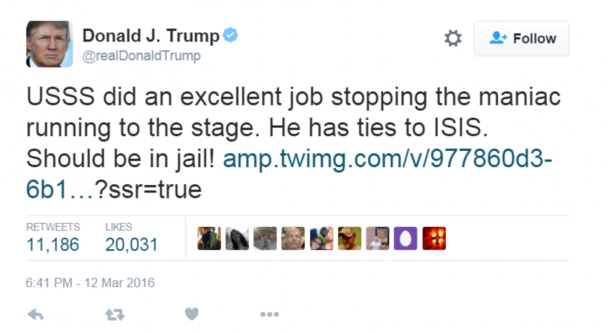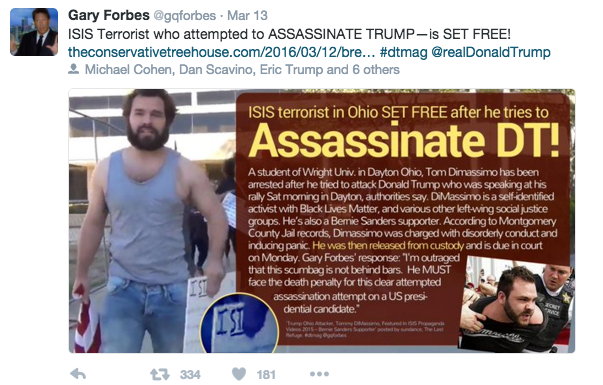Viral Misinformation and Political Engagement
On Saturday, March 12, 22-year-old political activist, Thomas DiMassimo, rushed the stage at a Donald Trump rally in attempt to express his political messages into the microphone. He was immediately detained by the Secret Service, and Trump continued speaking. Later that same day, Trump composed the following tweet:

There is one element to this tweet that virtually silences all of the surrounding information: that DiMassimo “has ties to ISIS.” Not only is this statement false, but it also has incredible implications for how Trump’s supporters – and people in general – perceive the world and engage in politics.
But this isn’t simply a tirade against Donald Trump, and it isn’t merely about posting inaccurate statements on social media. It’s about how misinformation online has the power to proliferate virally and disrupt legitimate political narratives. When inaccurate or outright falsified data and statistics are perceived as fact, people can use them as fodder to justify their worldviews. This is clearly problematic, and Trump’s tweet illustrates the social glitches misinformation can create. The basis of his assessment rests on a remixed YouTube video created by an Internet troll with no connection to DiMassimo. There was no verification of its correctness, and the result was a political fib.
Let’s further analyze Trump’s message to understand how misinformation can propagate through social networks: it was liked over 20,000 times, re-tweeted over 11,000, had a reach of over 231,000 users, and conceivably had impressions in the millions. That leaves quite a large number of people with the opportunity to absorb and relay this misinformation. For example, CEO of the Forbes Group, Gary Forbes, tweeted this on March 13:

It quickly becomes clear how misinformation can evolve, become embedded into our collective consciousness, and rapidly diffuse through networks from person to person ad infinitum. But what is the calculable net effect of online misinformation? Is there a way to link the perception of lies as truth and how people engage in political discourse?
Journalist Craig Silverman outlines this issue in a report he wrote while working for the Tow Center for Digital Journalism at Columbia University. The report, Lies, Damn Lies, and Viral Content, outlines both how viral misinformation spreads as well as the difficulty in reversing its consequences. It turns out that once people hear an impassioned political statement, they are inclined to hold onto it even after those statements are proven inaccurate. Silverman says:
“Misinformation is often more viral and spreads with greater frequency than corrective information. One reason for this is that false information is designed to meet emotional needs, reinforce beliefs, and provide fodder for our inherent desire to make sense of the world. These powerful elements combine with the ways humans process information to make debunking online misinformation a significant challenge.”
As well, the report provides journalists with the tools they need not only to avoid spreading mistruths, but also to correct misinformation where it occurs. According to Silverman, “Journalists today have an imperative—and an opportunity—to sift through the mass of content being created and shared in order to separate true from false, and to help the truth to spread.”
Overcoming moments of lies and misinformation like Trump’s tweet is a tenuous errand. If people latch onto lies even in the face of the truth, how can we trounce falsified information? Is it possible to convince people of the truth, even if they believe that what is correct is a lie? Craig Silverman believes so, and despite the challenge, it is a fundamental necessity for all rational people to speak out in the face of misinformation.
Andrew Ford @AndrewInAScreen
Emerging Media Graduate Student
Loyola University